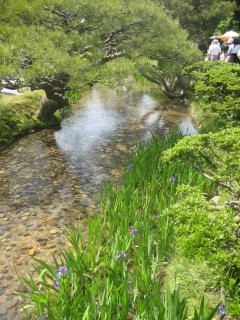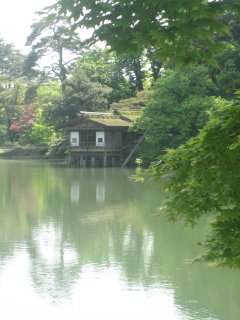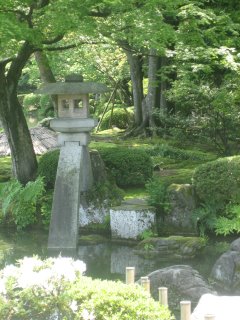 Kenrokuen Garden The first stop on any visit to Kanazawa should be, Kenrokuen. One of Japan's three most famous gardens, no matter how many times you visit it, you'll always find something new and interesting that will have you asking yourself how you could have missed something so beautiful the last time. No matter how crowded it gets, it always feels peaceful, and even if there's a tour group going by with squeaky voiced tour guide talking through a megaphone, there's a good chance you won't even notice because you'll be transported away by some little detail that you're busy investigating. Kenrokuen is set on top of a hill beside Kanazawa castle, and is a mossy, woodsy garden that feels very different from the brighter, more open gardens like Korakuen and Kairakuen. The foresty feeling helps you to forget about the thousands of people you are sharing the garden with, and there is something to offer the visitor in every season. Spring has beautiful cherry blossoms, and then in summer the park comes alive with so much greenery and so many beautiful flowers that it's almost overwhelming. Spring is the time for momiji, maple trees with tiny leaves will impress even Canadians and New Englanders who think they've seen it all. The word Kenrokuen is rather difficult to translate, but is usually rendered as "Garden of the six sublimities" or "Garden combining six". The name comes from the six attributes of the garden - spaciousness, seclusion, artificiality, antiquity, water, and beautiful views. Kenrokuen is special because there are very few gardens in Japan that combine all six of these important attributes. Once known as Renchi-tei, Kenrokuen was originally the garden of a tea house known as Renchiochin and work on it was first begun by the daimyo Tsunanori in the 1620's. It was improved and expanded over the years, and continued to evolve until the 1820's. It can get very crowded, so you are better off avoiding weekends and holidays.
Kenrokuen Garden The first stop on any visit to Kanazawa should be, Kenrokuen. One of Japan's three most famous gardens, no matter how many times you visit it, you'll always find something new and interesting that will have you asking yourself how you could have missed something so beautiful the last time. No matter how crowded it gets, it always feels peaceful, and even if there's a tour group going by with squeaky voiced tour guide talking through a megaphone, there's a good chance you won't even notice because you'll be transported away by some little detail that you're busy investigating. Kenrokuen is set on top of a hill beside Kanazawa castle, and is a mossy, woodsy garden that feels very different from the brighter, more open gardens like Korakuen and Kairakuen. The foresty feeling helps you to forget about the thousands of people you are sharing the garden with, and there is something to offer the visitor in every season. Spring has beautiful cherry blossoms, and then in summer the park comes alive with so much greenery and so many beautiful flowers that it's almost overwhelming. Spring is the time for momiji, maple trees with tiny leaves will impress even Canadians and New Englanders who think they've seen it all. The word Kenrokuen is rather difficult to translate, but is usually rendered as "Garden of the six sublimities" or "Garden combining six". The name comes from the six attributes of the garden - spaciousness, seclusion, artificiality, antiquity, water, and beautiful views. Kenrokuen is special because there are very few gardens in Japan that combine all six of these important attributes. Once known as Renchi-tei, Kenrokuen was originally the garden of a tea house known as Renchiochin and work on it was first begun by the daimyo Tsunanori in the 1620's. It was improved and expanded over the years, and continued to evolve until the 1820's. It can get very crowded, so you are better off avoiding weekends and holidays.

















0 件のコメント:
コメントを投稿